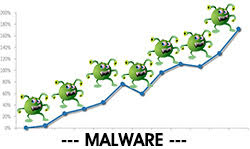Malware Tripled in 2015 Compared to 2013 According to Dell's 2016 Cyber Security Annual Threat Report
 Many times computer companies tend to analyze the industry in many different avenues, such as the area of computer security. Dell, a company well known for their consumer and business computer systems, has released their own 2016 Cyber Security Annual Threat Report summarizing the major threats that they witnessed and acted upon through the past year. In the report, Dell outlines how malware had tripled in 2015 when compared to 2013.
Many times computer companies tend to analyze the industry in many different avenues, such as the area of computer security. Dell, a company well known for their consumer and business computer systems, has released their own 2016 Cyber Security Annual Threat Report summarizing the major threats that they witnessed and acted upon through the past year. In the report, Dell outlines how malware had tripled in 2015 when compared to 2013.
Very similar to our very own predictions, malware has increased exponentially in the past couple of years where we see new threats like ransomware emerging to be one of the most aggressive types of malware threats in history. Dell experts revealed how their security products logged more than 64 million unique malware samples in 2015. The samples acknowledge a 73% rise from 2014 in the number collected and triple fold over the total number in 2013.
In Dell's assessments outlined in their recent report, similar numbers were also reported by other security companies, such as Panda Security. Security firms like Panda Security show numbers as high as 84 million new malware families within a total of 304 million malware samples during 2015.
Attacks are coming from all avenues in the retrospect of malware infiltrations. Dell alone blocked 2.17 trillion IPS (Intrusion Prevention System) attacks and 8.19 billion out-right malware attacks in 2015. The attack matrix is vast as Dell saw various types attempted on Android devices, not just desktop computers and servers.
Android malware has been thrown into the mix of threat assessments in the past couple of years. Naturally, we expect Android and smartphone malware to be part of the big picture as the numbers of devices grows to record numbers. What is even more frightening, as Dell is witnessing this year, is the expansion of banking Trojans and ransomware targeting the Android operating system.
On the front of Android malware, exploit kits are also being utilized as an attack method to land malicious software into smartphone and tablet devices without notification to the user. During 2015, Dell noticed that most exploit kits upgraded their coding and utilizes complex anti-forensic methods to evade detection by security applications. In all, such an approach makes it difficult to detect and track. Though, Dell and many other security companies are well aware of the influx of new malware spread through exploit kits, which are readily available to hackers and cybercrooks through the dark web and its forums.
What Dell foresees in the near future is an outbreak of malware to use SSL/TLS encryption for command and control server communications. What the use of encryption from C&C servers will mean is that it will get even harder for security experts to track and defeat such threats that are readily updated on the fly in such a manner.
Leave a Reply
Please note that we are not able to assist with billing and support issues regarding SpyHunter or other products. If you're having issues with SpyHunter, please get in touch with SpyHunter customer support through your SpyHunter . If you have SpyHunter billing questions, we recommend you check the Billing FAQ. For general suggestions or feedback, contact us.